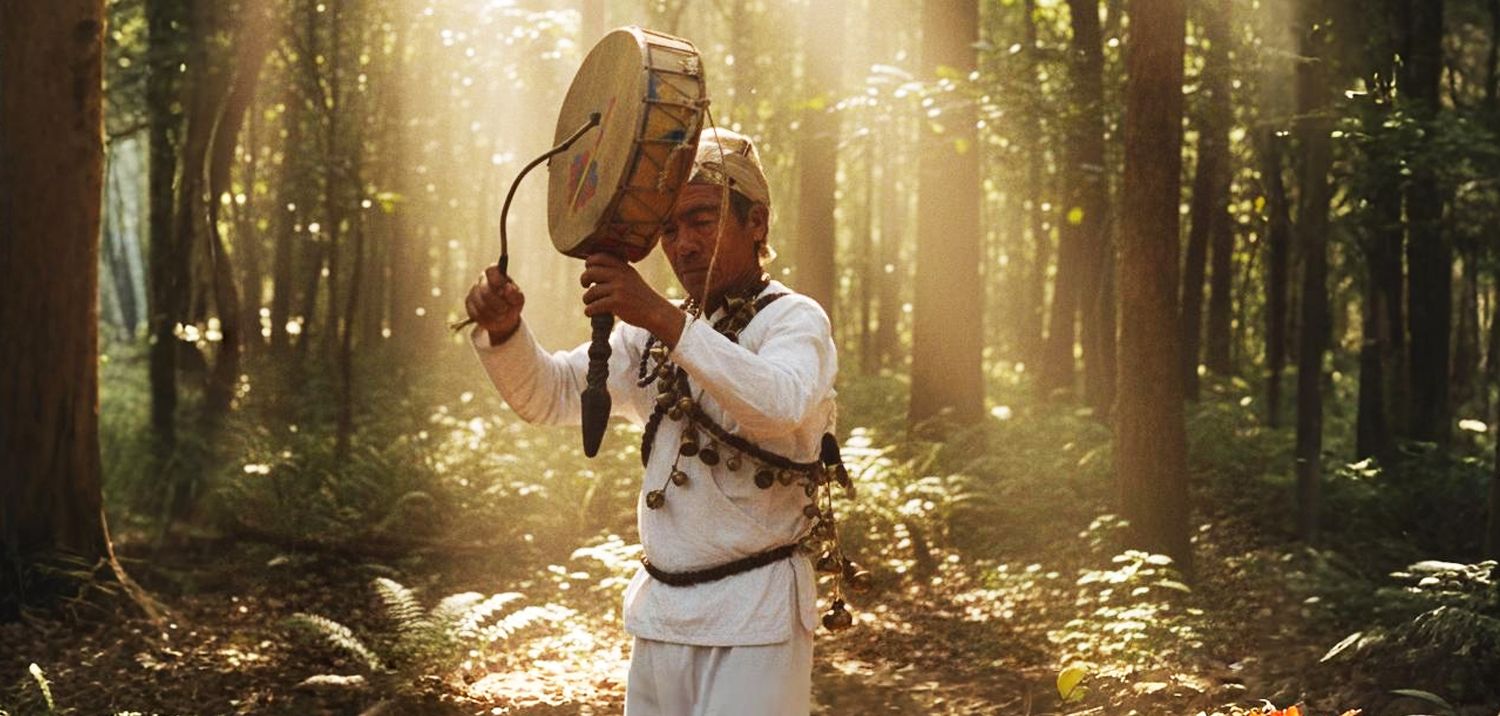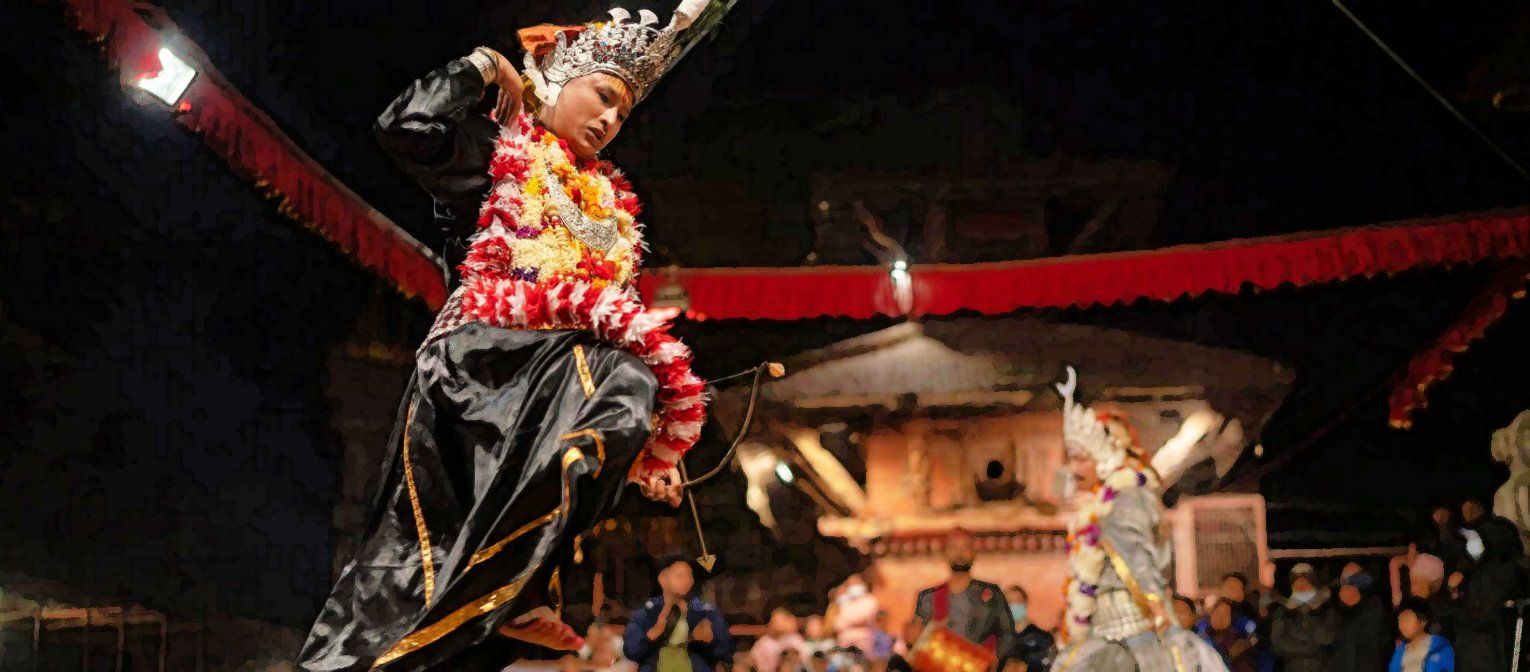The Bombo in Tamang Shamanism: An Overview
Shamanism holds significant meaning within the belief system of the Tamang people, whose worldview envisions a complex and unpredictable spiritual realm that deeply impacts the physical world they inhabit. Like many Himalayan communities, the Tamang perceive this liminal space as multifaceted, where the essence of beings and objects often eludes ordinary perception, and cannot always be understood based on their outward appearance. In Tamang cosmology, the universe is populated by a diverse array of spiritual entities—some life-affirming and nurturing, others disruptive or harmful—each embodying a spectrum of qualities that influence the delicate balance between the natural and spiritual worlds.
At the heart of this worldview is the belief in duality, where the material and the ethereal coexist and interact. This dual existence shapes the Tamang understanding of life, death, and the cosmos, guiding them through realms that extend beyond ordinary human perception. By navigating this intricate spiritual framework, Tamang Shamans, known as Bombo, serve as essential mediators between the seen and unseen worlds. For generations, the Tamang have upheld a rich indigenous knowledge system, transmitted through oral traditions and carefully preserved across time. The Bombo stand as the spiritual and cultural anchors of this knowledge, their practices and wisdom intricately woven into the very fabric of Tamang identity and social cohesion.
The journey of a Bombo, or Tamang shaman, begins with a transformative event known as the Lha khoba mayba, or “spiritual calling.” This calling often emerges during an intense crisis, described as a form of possession, when spirits—especially deceased shamans, known as Mukhiya Guru—overwhelm the chosen individual. While some individuals display shamanic predispositions from a young age, for most, the process unfolds gradually as they mature. Over time, the boundary between waking consciousness and dream states becomes increasingly fluid, and the individual begins to manifest unmistakable shamanic signs, signaling their growing receptivity to the shamanic realm and its transcendent forces.

During these early, chaotic experiences, those called by the spirits often seek isolation—sometimes retreating to ‘spiritually impure’ places within forests or in cemeteries, where they encounter terrifying visions of laagu (malevolent spirits). These unsettling experiences, referred to as ta rang gal (unripe visions), are seen as part of the initiation process. Over time, these experiences are interpreted as a person’s readiness to take on the responsibility of guiding others through the invisible, spiritual realm.
The apprenticeship to become a Bombo is a long and difficult process that blends ecstatic spiritual experiences with more grounded, didactic learning. During this training, the Bombo apprentice learns how to distinguish between laagu (harmful spirits) and lha (benevolent spirits). He also learns how to enter trance states, perform sacred rituals like Nawa (purification), and master ancient incantations. Central to this process is the Mukhiya Guru, the spirit of an ancestral shaman, who guides the trainee through dreams and visions, helping to refine his understanding and skills. Through four stages of initiation, the apprentice gains the ability to enter the spiritual world—symbolized by the opening of the ti sal borba (heavenly doors) atop their head, allowing them to fly through the spirit realm and gain clarity of vision.
In Tamang society, shamans are not a homogenous group. There are different types of shamans, each with a specific role to play. The Bompo, for example, are deeply connected to nature and the land. They act as guardians of sacred places, performing rituals that honor spirits of the earth and ensure the fertility of the land. The Dangur are mediums, who become vessels for divine or ancestral spirits during rituals, delivering messages and blessings to those in need. Then there are the Rite Guru, whose practices are more closely tied to Buddhism. They perform rites of passage and help guide the souls of the departed toward their next rebirth, bridging shamanism and Buddhist teachings.
The roles of the Bombo are many, but they all revolve around the core principle of spiritual mediation. As healers, they diagnose ailments that are believed to be caused by spiritual imbalances, such as bla gumne (Saato haraunu/loss of life force). Using rhythmic drumming, chanting, and trance, the Bombo retrieves this lost energy, expelling laagu and restoring balance. They also lead community rituals at sacred sites, reinforcing the relationship between the people and the land. Just as importantly, Bombo are the keepers of the Tamang oral tradition. They are the ones who tell the ancient stories, preserving the myths and genealogies that define the Tamang identity.
The cosmology of Tamang shamanism is rich and complex, filled with heavens, middle realms, and underworlds. The dawa lung gyesar gyolpo (heavens) are home to benevolent gods and spirits, while the underworld jhao is inhabited by malevolent forces associated with death and decay. The Tamang landscape is also imbued with spiritual power. Sacred groves, springs, and mountains are seen as places where the boundary between the physical and spiritual worlds is thin, and where rituals can more easily connect the two. Through their rituals, the Bombo reinforce the idea of sibda neda than, a harmonious relationship between humans and the sacred environment.

Rituals are central to the practice of Tamang shamanism, and they’re not just individual acts but collective experiences. When performing rituals like the Nawa, the Bombo enters a trance, their body trembling as they call upon the Mukhiya Guru for guidance. These rituals, marked by drumming, chanting, and symbolic gestures are actually spiritual negotiations that attempt to appease spirits or warding off of harmful forces in the community. The Damphu, the traditional Tamang drum, plays a central role in these rituals, helping the Bombo enter a trance and bridge the gap between the physical and ethereal worlds. These acts are not just for healing; they are also for the collective renewal of the community’s spiritual strength.
One of the most captivating aspects of Tamang shamanism is pho wang lung (magical flight), where the Bombo journeys into the spirit realm. These flights aren’t chaotic or uncontrolled like the visions of novices; they are deliberate, clear, and purposeful. The Bombo uses incense and spirit invocations to guide their soul through the unseen world, retrieving lost knowledge or souls and bringing blessings to the community. These journeys symbolize the Bombo’s mastery over the spiritual forces that govern their world, and they represent a deep understanding of the interconnectedness of all things.
Tamang mythology tells the story of Dunjur Bon, the first shaman, who fell from the celestial realms after a confrontation with Guru Pema, the first lama. This fall marks the beginning of duality in the world—dividing the pure, primordial time of thungsa from the earthly, cyclical nature of kesa. Dunjur Bon’s descent is seen as the birth of the shaman’s role as a mediator between these two worlds—one ethereal, the other physical. The shaman’s task is to navigate this duality, healing, guiding, and restoring balance to both realms. This myth perfectly encapsulates the Tamang understanding of the world, where everything is interconnected, and the boundaries between realms are fluid.
Yet, it’s impossible to ignore the influence of other religious traditions, especially Buddhism and Hinduism, on Tamang shamanism. Hindu deities like Shiva and Kali have found their place in Tamang rituals, while Buddhist concepts like karma and rebirth shape ceremonies for the departed. Tantric practices have also left their mark, particularly in the use of mantras and the belief in energy centers akin to chakras. This syncretism has enriched Tamang shamanism, but it has also led to shamanism being marginalized as a “primitive” practice.
For modern Tamangs, shamanism is a powerful link to their ancestral roots, providing not only spiritual guidance but also a sense of identity. It continues to address the challenges of rural and semi-urban communities, offering healing and wisdom deeply tied to their worldview. Tamang shamanism, with its rich oral traditions and spiritual practices, ensures that the cultural heritage of the Tamang people will continue to thrive. The Bombo, in collaboration with the Tamba (or Ganba)—the traditional storytellers who preserve clan genealogies and cosmogonic myths—are the guardians of this sacred knowledge. Together, they protect and nurture the Tamang identity, ensuring that the wisdom of their ancestors is passed down for generations to come.
As healers, mediators, and cultural guardians, the Bombo exemplifies the enduring relevance of shamanism, answering humanity’s spiritual and existential needs. Preserving this tradition is not merely about safeguarding the past; it is about ensuring that the richness of the Tamang worldview endures—not only for their community but as an invaluable part of global cultural heritage. In a world of constant change, Tamang shamanism offers not only a vital framework for cultural survival but also a “decolonized perspective”—one that reimagines the world through a lens of spiritual interconnectedness, resilience, and ancestral wisdom.








